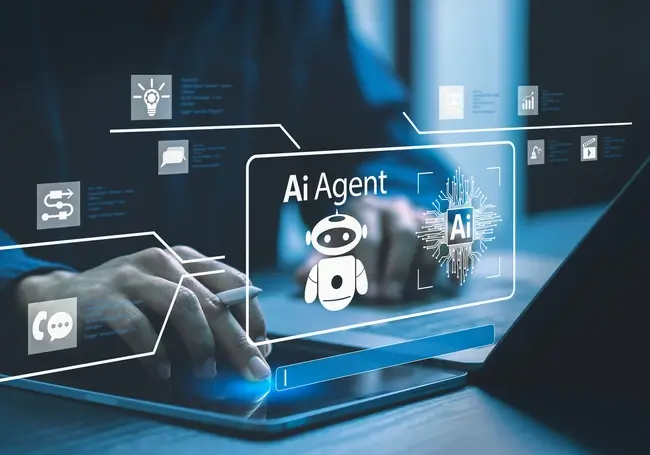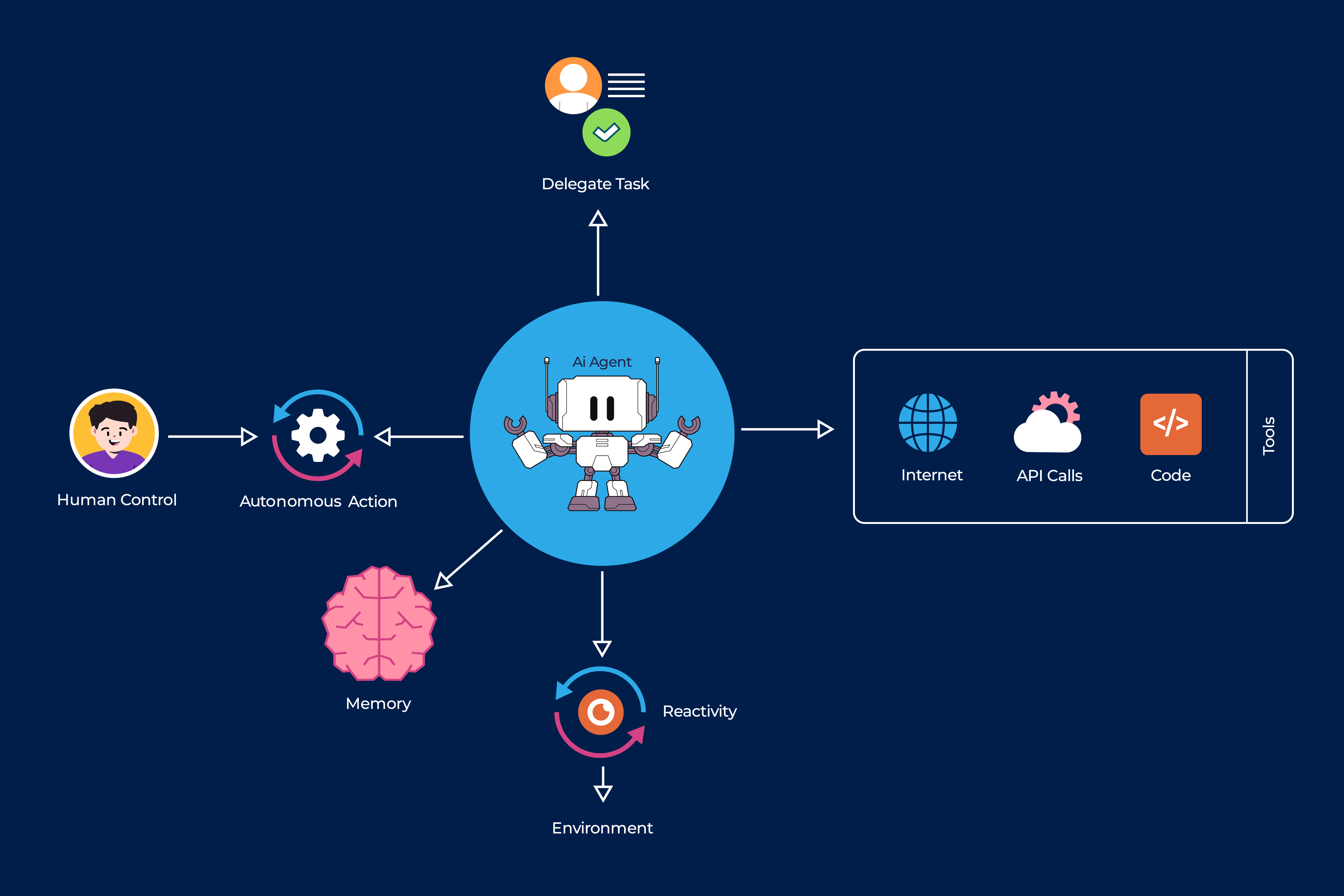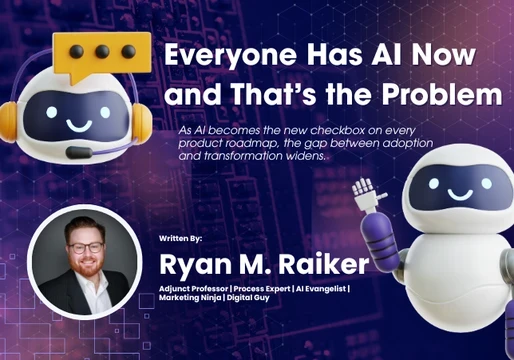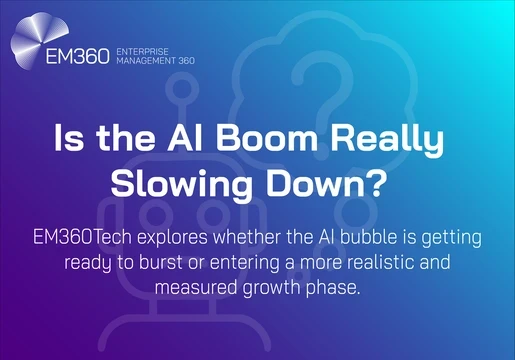Autonomous agents represent the next evolution of intelligent systems, capable of handling everyday tasks, adapting to change, and keeping operations running smoothly without constant human input.
At their core, these agents can independently complete sequences of tasks while learning and improving over time. Through this, businesses are beginning to see how these tools can ease workloads and improve customer experiences.
The global artificial intelligence market is projected to soar to $1.8 trillion by 2030, according to Statista. Nearly 90 per cent of business leaders believe AI will play a key role in driving revenue growth. This confidence stems from AI agents’ ability to tackle complex challenges directly. While companies leveraging AI agents have reported a 55 per cent boost in operational efficiency and a 35 per cent reduction in costs.

So, what’s driving all the excitement, and is it really worth the hype? First, let’s define exactly what autonomous agents are.

What Are Autonomous Agents?
Autonomous agents are intelligent systems capable of independently carrying out complex workflows. Unlike traditional AI systems that require step-by-step instructions, these agents interact with data from trusted sources to provide immediate, real-time insights.
Whether streamlining customer service operations or enhancing data management, autonomous agents are engineered to adapt and excel in diverse business environments. Autonomous agents bring flexibility and intelligence to various business functions, be it improving customer service, managing data, or supporting operational workflows.
How Do Autonomous Agents Operate?
Autonomous agents are intelligent systems designed to execute complex tasks quickly, minimise errors, and reduce operational expenses by automating workflows and managing multiple activities simultaneously.
Businesses, particularly in the fintech and banking industries, use these agents to scale their operations and help improve risk mitigation through continuous monitoring and predictive insights.
By automating decisions and streamlining processes, autonomous agents empower companies to boost efficiency, maintain compliance, and elevate customer service, keeping them competitive in fast-paced markets.
These agents rely on a blend of technologies such as machine learning, natural language processing (NLP), and real-time data analytics.
Here’s a breakdown of their working mechanism:
- Data gathering: Autonomous agents begin by collecting information from different sources—customer interactions, transaction records, and external databases to gain context and understand the task at hand.
- Analytical decision-making: Leveraging machine learning models, the agents analyse this data to detect patterns and predict outcomes. For instance, a customer service agent may review past conversations to craft the most effective response to a query.
- Task execution: Once a decision is made, the agent carries out the necessary actions, such as answering questions, processing transactions, or escalating issues to humans, ensuring smooth and efficient operation.
- Continuous learning: Autonomous agents improve over time by learning from each interaction. Using techniques like reinforcement learning, they constantly refine their algorithms and expand their capabilities to handle a broader array of scenarios.
In essence, autonomous AI agents are not just an upgrade; they represent a transformative shift in how companies leverage technology to outperform the competition.
Have a look at this video made by EM360Tech Ben King:
Benefits of Autonomous AI Agents
Autonomous AI agents deliver a range of advantages thanks to their independence, responsiveness, and proactive problem-solving abilities.
Here are six benefits of using an autonomous AI agent:
1. Improved efficiency
These agents excel at completing intricate tasks swiftly by processing large amounts of information quickly. Their ability to multitask and adapt to evolving conditions makes them invaluable. In fintech, this translates to faster transaction processing, reduced manual errors, and compliance through real-time transaction monitoring.
2. Accuracy
Autonomous agents offer precise data processing and decision-making, reducing the risk of human error. This reliability is critical in detecting anomalies, flagging suspicious activities, and ensuring adherence to regulations in any organisation.
3. Cost reduction
By automating routine processes, AI agents lower operational costs. Their 24/7 availability allows businesses to reallocate human resources to higher-value tasks, improving overall productivity. Handling multiple requests simultaneously also reduces the need for people.
4. Scalability
AI agents can easily scale up or down to meet changing workloads without proportional cost increases. For instance, a service delivery company can manage rising customer demands or expand services efficiently, without the need for large-scale human resource adjustments.
5. Improves risk management
Continuous transaction monitoring, combined with predictive analytics, allows autonomous agents to identify potential risks and anomalies in real-time. This capability supports proactive risk mitigation strategies, helping to avoid financial losses.
6. Competitive edge
Integrating autonomous agents into daily operations helps with innovation by enabling smarter decisions, cost efficiency, and consistent service availability.

Understanding The AI Hype
Artificial Intelligence has quickly become a central theme in technology discussions, influencing how businesses plan their future and drive innovation. From advanced agents such as ChatGPT to generative models like Stable diffusion-producing imagery, AI tools are showcasing capabilities that were once considered science fiction.
Leading technology companies are positioning AI as a transformative catalyst that will disrupt traditional industries and redefine societal norms. Yet, amid this surge of optimism, it’s important to ask: Is AI really delivering, or are expectations outpacing reality?
In many cases, AI is transforming workflows and unlocking new efficiencies. But without clear strategies and governance, it can fall short, making it crucial for businesses to separate genuine value from inflated expectations.
Hype vs. Reality
Artificial Intelligence has become the poster child for digital transformation, promising smarter operations, predictive insights, and entire business models reimagined overnight. From boardrooms to social feeds, AI is positioned as the future of everything. But as headlines grow bolder and product launches more ambitious, the divide between expectations and reality is becoming harder to ignore.
How much of this is real progress, and how much is marketing spin? Let's take a look at the factors that have hyped up AI:
- Surge in powerful AI tools: Recent advancements have made AI tools more accessible and user-friendly. Models such as OpenAI’s ChatGPT and DALL·E, along with Google’s Gemini, have captivated users by producing human-like conversations, creative images, and sophisticated responses, bringing AI into mainstream awareness.
- Media amplification and investment: The media’s fascination with AI often highlights its best features, while major tech companies pour billions into AI research and development. This creates a reinforcing cycle where investment, media coverage, and public interest continuously fuel each other.
- Business FOMO (fear of missing out): Companies across sectors feel pressured to adopt AI quickly to avoid falling behind competitors who are already using AI to improve efficiency, innovate products, or improve customer experience. This urgency can lead to rushed implementations driven more by hype than strategy.
Recognising the forces driving the excitement allows us to evaluate bold claims more critically and distinguish real progress from polished promotion. Like the internet and blockchain before it, every transformative technology goes through its own cycle of hype before its lasting value becomes evident.

Where the AI Hype Falls Short
Although significant progress has been made, widespread misunderstandings continue to cloud public perception of AI:
- Human-Like thinking? AI’s outputs sometimes lead to overestimating its cognitive abilities. AI systems rely on pattern recognition and statistical analysis rather than genuine reasoning, empathy, or deep contextual understanding.
- Fully autonomous vehicles still face technical and regulatory challenges, delaying mass adoption.
- AI can help in legal and medical fields, but can’t yet take the place of careful human judgment and ethical decisions.
- It’s still unclear when machines will think like humans, and we’re a long way from that happening. This AI misconception has been hyped dramatically.
What Drives the AI Hype?
The growing excitement around intelligent technologies is shaped by a mix of factors from investment trends and marketing strategies to public understanding and media coverage, which together amplify expectations beyond current realities.
Let's have a look at these factors that have fuelled the AI Hype:
- Venture capital: The chase for the next AI “unicorn” fuels heavy investment and ambitious claims.
- Marketing buzzwords: “AI-powered” has become a catchphrase applied broadly, sometimes with little substantive AI integration.
- Knowledge gap: AI’s complexity and rapid evolution make it difficult for many to distinguish hype from reality.
- Sensational journalism: Media outlets prioritise eye-catching AI stories to attract attention, often at the expense of accuracy.
- Education: Adaptive learning platforms tailor content to individual students’ needs and pace. This is the case of learning disabilities or subject preference.
When the AI Hype Is Warranted
Even with all the excitement, there are clear ways these smart technologies are making a real difference and helping businesses improve.
- Breakthroughs in machine learning: DeepMind’s AlphaFold, which predicts protein structures with unprecedented accuracy, exemplifies AI’s scientific potential.
- Productivity tools: AI-driven automation saves time and costs across industries.
- Improved human-computer interaction: Natural language interfaces and AI assistants make technology more accessible and intuitive.
- Creative democratisation: AI enables more people to generate text, visuals, and videos, expanding creative possibilities.
Real-World AI Applications
Beyond the headlines, AI is already proving its worth in practical scenarios, including:
- Financial institutions: use advanced technology to spot and stop fraudulent transactions as they happen, streamline the process of evaluating loans and credit risks, and offer personalised investment advice through digital assistants tailored to individual customer needs.
- Customer experience: Chatbots efficiently handle routine customer inquiries, providing quick and accurate responses that free up human agents to focus on more complex and sensitive issues.
- Medical Diagnostics: AI supports early disease detection by analysing imaging data and speeds up the process of developing new medicines.
- Predictive maintenance: AI monitors industrial equipment to forecast failures, reducing downtime and maintenance costs.
The Reality of AI
The reality of AI in 2025 is a blend of great progress and ongoing challenges. According to recent market analyses, the global AI market is expected to reach around $900 billion this year, reflecting rapid adoption across industries such as healthcare, finance, and manufacturing.
Enterprises increasingly use AI-powered tools, including autonomous agents and generative models, to automate routine tasks, enhance customer experiences, and support decision-making. Over 85 per cent of large organisations now report integrating AI into at least one core business function, signalling a strong commitment to digital transformation.
Despite the impressive growth, many businesses still face hurdles in unlocking AI’s full potential. A survey of technology leaders found that while 70 per cent see AI as critical to their strategy, only 30 per cent feel their AI implementations are fully mature or delivering expected returns.
Common obstacles include data quality issues, integration complexity, and skill shortages. Security concerns are rising, with over 90 per cent of IT professionals identifying AI-related risks such as data breaches and adversarial attacks as key challenges that need great governance frameworks.
To use AI responsibly, it’s important to balance excitement with a clear-eyed view of its limitations.
This requires the following:
- Transparency: Clear communication about AI’s capabilities and constraints.
- Ethical focus: Addressing bias, fairness, and accountability in AI development.
- Public education: Increasing awareness and understanding to empower informed engagement.
Impact of AI Innovation Beyond the Hype
As AI technologies continue to advance in natural language processing, reinforcement learning, and real-time analytics, the gap between AI’s hype and reality is steadily narrowing. Industry forecasts predict that by 2025, up to 75 per cent of customer service operations will leverage autonomous AI agents.
These advances in machine learning and edge computing are enabling smarter, more capable agents that can handle complex tasks with greater efficiency. While these technologies offer significant potential for innovation and improved performance, organisations must address challenges related to security, governance, and integration to fully unlock their benefits.
- Spotting real AI innovation versus hype requires asking critical questions when evaluating AI claims.
- What tangible problem does this technology solve?
- Is there credible scientific evidence supporting these claims?
- Does the solution demonstrate true intelligence and adaptability, or is it just automated processes?
- Most importantly, are the promises measurable and testable in real-world scenarios?
These questions help businesses separate genuine breakthroughs from marketing buzz and make informed decisions about AI investments. We get it the hype is hard to ignore but researching different AI tools will benefit the organisation in the long run.
Looking ahead, the road beyond the hype points toward AI tools that are more mature, reliable, and governed by industry standards and regulations. Human-AI collaboration will likely become the norm, with AI augmenting rather than replacing human expertise. Responsible AI practices centred on ethics, fairness, and transparency will be essential to sustainable adoption.
It will also be important to increase investment in AI literacy among the public and policymakers, empowering more informed and balanced decision-making to ensure AI’s benefits are widely and responsibly used.







Comments ( 0 )